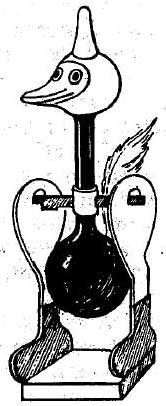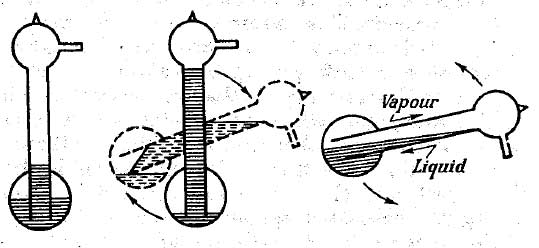Insatiable Birdie
The following is excerpted, with permission of the publisher, from Physics for Entertainment
By Yakov Perelman

Insatiable Birdie
Fig. 99
There is a Chinese toy which is a perpetual source of astonishment and delight. This is the "insatiable birdie". Put before a drinking bowl, the "birdie" will dip its beak in the water and having "drunk its fill", swing back into its initial upright position. After a while, it slowly leans over to dip its beak in the water again, "drinks" and swings back. This is a typical "gift-motion" machine, One, moreover, based on an extremely ingenious principle. Look at Fig. 99. The birdie’s "body" consists of a glass tube ending at the top in a little head-shaped sphere, and inserted at the bottom into a broader similarly air-tight reservoir filled with ether up to a level a bit higher than the open bottom end of the tube.
To cause the birdie to "drink", its head must be wettened with water. For a while, we see it still upright—since the bottom reservoir with the ether is heavier than the head. Then we see the ether gradually rise in the tube (Pig. 100), finally making the upper part heavier and causing the birdie to lean over and dip its beak in the drinking bowl. When the birdie swings into a horizontal position the tube’s open bottom end takes up a position which is above the level of the ether in the bottom reservoir, thus causing the ether in the tube to flow back into the tail reservoir, and the birdie, consequently, to swing back into its initial upright position This is the mechanical aspect of the problem; as the ether rises and returns, the centre of gravity shifts.
But what compels the ether to rise? Ether easily evaporates at room temperature, while the pressure that saturated ether vapours exert greatly varies, when the temperature fluctuates.
When the birdie is in its upright position, there are two clearly distinguishable zones of ether vapours. There are the "head" tube and the "tail" reservoir.

The birdie’s secret.
Fig. 100
Now the "head" possesses the remarkable property of lowering its temperature in comparison with that of the: surrounding environment. This can be achieved by making the head of a porous material well able to soak in moisture and intensively evaporate it.
In Chapter Seven I told you that intensive evaporation causes a drop in temperature. Since the headtube’s temperature becomes lower than that of the tail reservoir, this causes a drop in the pressure of the saturated vapours in the head-tube, thus compelling the ether to be forced up the tube by the greater pressure of the vapours in the tail reservoir. The centre of gravity shifts and the birdie swings into a horizontal position. Then two absolutely independent processes take place. In the first place, the birdie wettens its beak and thus soaks its cotton wool head. Secondly, the saturated vapours in the head-tube mix with the vapours in the tail reservoir. Pressure evens out (owing to the heat of the surrounding air, the ternperature of the vapours rises slightly), and the ether flows back by gravity into the tail reservoir, causing the birdie to swing back into its upright position again.
This "nodding" continues while the cotton wool head is wet and provided the humidity of the surrounding air is not too great.
These two factors will guarantee normal evaporation and the consequential relative drop in the headtube’s temperature. It is thus that the warmth of the surrounding air imparted to the birdie all the time causes it to nod.
http://www.amazon.com/Physics-Entertainment-Yakov-Perelman/dp/1401309216











